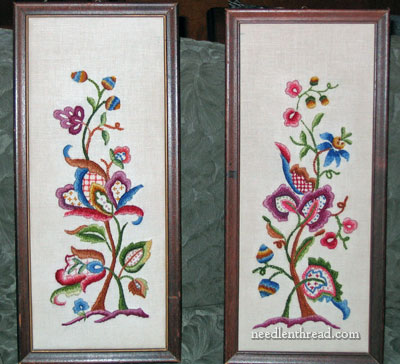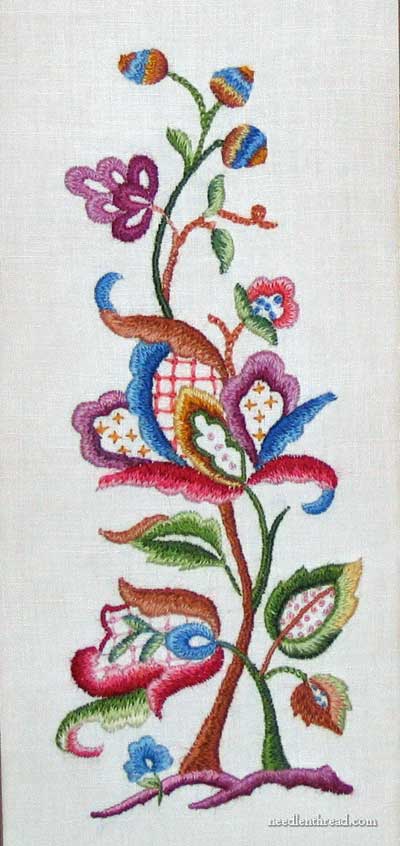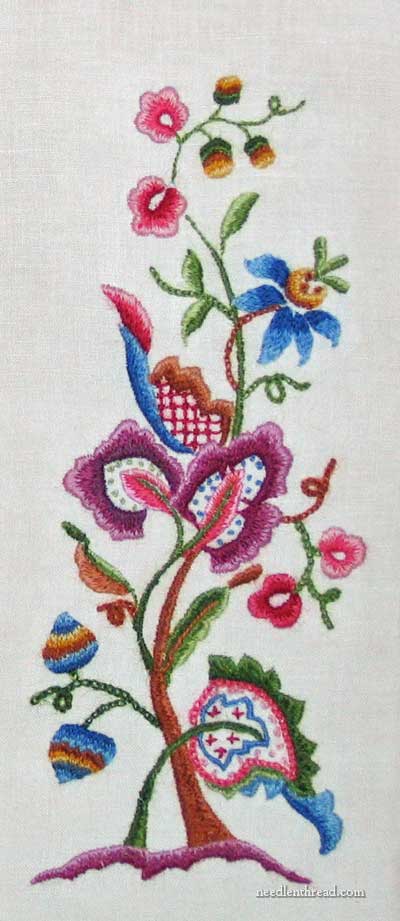Last week, I was delighted to hear from a reader & fellow stitcher I hadn’t heard from for a while! She wrote and sent a picture about a clean up job that she recently undertook on some embroidery. There are two reasons I’m sharing her story and photo with you: 1. There’s some good information here about cleaning a piece of time-stained needlework; and 2. The needlework is quite vibrant and pretty! I think you’ll like it.

JoWynn had two pieces of crewel embroidery stitched by her grandmother in the 1960’s, and both pieces were wrapped around cardboard and framed behind glass. Over time, the linen had become darkened and discolored and stained by the frames (and probably by the cardboard, too), so she wanted to clean them up and properly mount them for display.
She didn’t want to pay a rather large price (with shipping) for just the small amount of Orvus she would need to clean the pieces up, so instead, she researched the ingredients and found an old bottle of shampoo, the first ingredient of which was sodium lauryl sulfate. She decided to take a chance. She made up a sink full of suds with the shampoo… and submerged the two pieces of embroidery!

The conclusion: “The embroideries came out looking beautiful. The linen is closer to what I assume was the original color. At least, it is paler than it was, and the woolen colors look much brighter and richer against it.”

Aren’t the pieces wonderful? So rich and vivid! I would never have associated these colors with crewel kits from the 60’s – but it just goes to show you that certain things – including color schemes – do withstand the test of time. And I think JoWynn’s clean-up job will ensure that her grandmother’s embroideries will continue to withstand the test of time beautifully!
Just a little note: This worked magnificently for JoWynn! I tend to be a little more cautious, unless I’m already at the Last Resort stage. If possible, you should always test first before submerging whole pieces of embroidery into an unsure solution. Shampoos today can contain products that can leave residue behind, too, so be sure of your ingredients and of their effects before you launch into a clean-up job.







Wow – those are very pretty! JoWynn is fortunate to have them. I’d say those are classic designs, maybe done in colors a bit brighter than we usually think of being used traditionally. Maybe. Perhaps the old examples we see would be this bright if they had just had a good soaking. But then, all I really remember about crewel kits from the past are the frog/turtle/ladybug/mushroom laden designs from the 70’s.
I’m glad the shampoo worked out, I have a couple of items I need to clean also. It seems like Orvus is another of those products that is repackaged for quilters and needleworkers and then the price goes way up. It’s a great product though.
Johnson’s Baby Shampoo is usually a good bet — gentle (no tears!)and the additives are minimal. And the shampoo-thing makes sense for the wool — it is “hair” afterall! I have used this on crewel pieces in the past and have been pleased with the results. Surprisingly, the whole cleaning process affects the crewel wool very little — and the “typical” fabric ground (twill) is very sturdy stuff.
Beautiful – I have some pieces I did in the early 70’s that were hung in my parents home and have suffered cooking and smoking residues – would this Orvus work? I was going to try an “Oxy” type of soak and see what I can do. This is an excellent topic for a lot of us stitchers out here. Finishing, framing, and cleaning seems to be my point of contention – I have soooo many unframed pieces as matting and framing have become prohibitively priced.
My mom did so many crewel pics back in the 70/80. Ud think they were bought. Talented in more ways u could imagine. Unfortunately the pics are stained w/pall mall cigarette smoke!! How to clean them. I’d love to know. She did all of hers on muslin fabric. Any ideas would certainly be most appreciated and loved.
Hi, Kittty – you might look for a small bottle of Orvus through quilt shops. They often sell it repackaged in small containers. Make up a bowl of water with a few teaspoon or so, and try soaking a corner of the piece, to test it. If you’re brave enough to go all in, soak the whole piece. It’s impossible to know how colorfast the threads are, though, without testing, but if you’re determined to get them clean, it may be worth just going for it, to see what happens.
I just stumbled on this thread looking for a solution to cleaning my grandmother’s wool crewel work. Right now they are are sad little pillow cases that have found a permanent home in my closet. I plan on framing mine when they are clean. American frame is very reasonable, prices are fraction of a frame shop. You have to assemble them yourself but it is worth it to get the stuff out of storage. Imho,
On your theme of finding things in other places… Tractor Supply and most tack shops stock Orvus. I bought a gallon-sized container of it from Tractor Supply before I moved to Uruguay, and have most of it left. When I want to use some, I just dip a spoon in and let most drip off. It works wonders on antique beaded purses.
Also, you’re right on the shampoo. A lot now contain smoothers (silicone based) and shiners that are meant to stay on the hair after rinsing. Wool is a protein just like hair, and so the residue will possibly bind to the wool.
Que bueno que funciono, por que la verdad es un trabajo precioso, yo tambien soy muy cuidadosa al lavar prefiero probar con un pedazo de tela primero. Pero me alegro que pudieras rescatar ese trabajo magnifico.
These are beautiful!
I have a vintage piece that unfortunately has a stain from the adhesive on a price tag. Any suggestions?
Beautiful pieces!
Orvus is actually horse shampoo and can be purchased/ordered from farm supply stores for cheap. Once a quilt shop gets it’s hands on it, the price skyrockets.
Agree with other comments regarding human shampoo – if you use it, be sure to choose one with no silicones in the ingredient list (silicones end in -one or -silane or -siloxane).
Thank you for your wonderful articles Mary!
The vintage pieces are a treasure!
I enjoyed seeing these pieces – they remind me of a pair I did from kits, probably in the 1970s. The colors in my kits were equally bright, but tended more towards oranges and golds. Thanks for an interesting article!
Mary in MN
Very interesting artcile. I’ve had some pieces come across my worktable that needed help, not with cleaning, but de-smelling. Many have had mildew and some have smelled of cigarettes. I am allergic to mildew, so I tell my clients that they have to submit to cleaning before I can work on their pieces. What I’ve learned works best is to take drying crystals, the kind you use to dry flowers in. I have a huge container of crystals and pour it into a plastic bin that I can seal. The piece gets put in and covered completely. The lid goes on and it stays that way for two weeks. I do a smell check weekly after that. Usually within a month the problem is gone. I use a clean dry paintbrush to sweep away leftover crystals. Works great on old paper and books too! Thanks for your wonderful tips!
Most cleaning products are optimized for cleaning a certain type of soil, such as grease, grass, dirt, etc. They are generally formulated only secondarily for the substrate, or fabric, in our case. Sodium laurel sulfate works very well on any type of greasy soil irrespective of the substrate, whether wool and silk (animal) or cotton and linen (plant). It is also used as a degreaser and as a car wash, albeit in greater concentrations than used for horses or quilts.
If you don’t have a saddle and tack store nearby, the next best thing is inexpensive shampoo without all the smoothing additives whiach are generally silicones that want to stick to the substrate and will pick up all sorts of dirt and grime from its surroundings.
Oxygen bleaches (OxyClean and Biz) tend to work exceptionally well on cotton fabrics; I’ve used them extensively for this. But I haven’t uses them to clean wool threads as I haven’t yet had the need to do so.
Quite a few years ago I had a piece of crewel I was working on that had become dirty and then my cat peed on it. I had nothing to lose at that point. I used Dreft laundry detergent because it was labeled as gentle and safe for babies’ clothes and diapers (back when cloth was more common). I believe I simply soaked it in a solution of the detergent and it worked wonderfully. Now I just need to get it out of the UFO box.
Just remember, folks, one of the tests to check fiber content in yarn is to drop a bit in concentrated bleach–and if it disappears, it’s wool.
So no chlorine bleaches, don’t care how ‘safe’ they are supposed to be!
Might I suggest getting together with your local 4H sheep project and getting your Orvus that way? I know they use a LOT near fairtime but there’s always room for someone to chip in a couple of bucks and walk away with a half pint or so that will last you forever….just make sure that you get the FIRST dip into the jug. 🙂
I have been using castile soap for all my fine washing or soap from the Vermont soap company. I love the natural smell that is left behind and it rinses away very easily.
Those are beautiful! The colors are so bright and fun. So glad the shampoo helped clean up the fabric. Great bit of advice.
What about using a solution of Dawn dish liquid and water. It’s supposed to be harmless to animals. My husband has a large crewel embroidered picture done on dark grey fabric. It’s hard to tell what fabric it is, but it doesn’t look like linen. I would like to clean it up some as it is in our guest bathroom in the foyer. It was custom framed in Charleston,SC some years ago.
Please send me any suggestions you might try.
Thanks,
Sally Welch
Whilst recentlry clearing the attic of the house we have lived in now for only 2 years I came across an old suitcase with four framed tapestry/embroidery pictures.
I am not even a novice when it comes to these things but they look magnificent in bright colours ( some metallic looking ) golds and blues.
the pictures have on the back (the needlewoman regents street london).
I am trying to find out as much information as possible on these but I am finding it very difficult.
could you help please with pointers as to where to look or go.
1. is a picture of pink and cream orchids on a red base with woolen type thread and some gold outlines.
2. is a picture of what can only be described as a crested bird in fine thread of teal/black and gold colours on a light grey base with gold coloured twigs and teal and gold flowers and butterflies.
3. is of a deep red rose (silky)on a black base
4. looks like snow drops and violets in silk on a black base.
hope you can help
steve jackson
Can you give the name of the shampoo? I would like to try this and clean up a pice an aunt made years ago.
Thanks!
Pat
I am not a quilter
Hi, Pat – you might just try Ivory soap, the clear liquid. I don’t know that JoWynn is still keeping up with this article…. -MC
I have 2 famed beautiful cross stitches that I want to clean. I saw a demonstration using Lavender Eucalan to clean them while they are still in the frame but I can’t find it. Can you direct me?
Hi, wonder if you can give me some advice. I have two older wing chairs with off white linen upholstery and slightly darker off white crewelwork all over them. Probably at least 30 years old. Love the chairs but they are time-stained and look dirty. I cannot find any information about how to clean these. Have asked at a couple of drycleaners with no success. Next to my clean off white quilted drapes they look nearly gray in indoor lighting. Any suggestions? The entire chair needs to be treated. Thanks
I have a creek embroidery kit that my grandmother purchased bit wasn’t able to do, flash forward 35 years, I’m going to complete the project my problem is my mother stored it in some rather fragrant places and the odors are in the thread and linen, do you have any ideas how to freshen up? The stamping on the linen is very fragile, washing would eliminate most of it.
Thank you for your time and consideration, I’m anxious to hear any ideas you may have
I have an antique tablecloth embroidered with wool . There are stains… how do I clean it?
I have a framed piece of crewel that was given as a gift 42 years ago when my first son was born. I have kept it in the attic since he’s grown an out on his own. The piece is very dusty and has stains of some sort. I want to clean it up and give it to his recently born daughter. The piece seems to be tightly stapled and glued to the frame and I can’t remove it without damaging it. Does anyone e have any idea how I might clean the piece? The dry cleaners won’t touch it.
Good article, helpful. I’ll try it on a piece of crewel that I started in the 80s and never finished, but it’s managed to get some small stains on it. As for colours from the 60s, of course they would be bright! That’s what the 60s was all about, bright colours. And if you go back in time to Jacobean embroidery, which was where crewel embroidery started, it was all very bright, as were the insides of their houses, apparently.
If anything, I find current times to be very drab, all the grey, black and white, and the embroidery kits are so simplified as to be uninteresting. Can’t find any that I like now, so I’m trying to get some from England, but after 3 tries to get them to actually land here, I’m beginning to think I’ll have to travel to get them.
Need a embroidered wall hanging cleaned and framed
Hi…this is wonderful I’ve been wondering how to clean mine. Question…did she remove the linen from the frame and wash, or just submerge the whole thing in the sink?
Removing the linens seems like quite a daunting job and I’m not sure I could get it back on the board to reframe it!
Thank you so much!
I’m sure she removed it from the frame.
Geez, I found this article I’d torn out of a magazine for it’s paint color, ID and source, the other side having an article on Crewel Embroidery. I’ve never known that my liking this sort of thing has a name! Crewelwork. Realy keen!